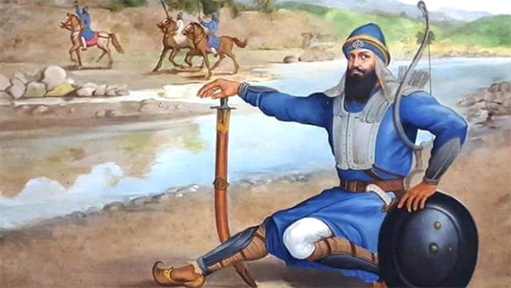7th July

1656 Prakash Utsav, Eighth Patshah, Guru Har Krishan Ji. Guru HAR KRISHAN Patshah (1656-1668), was born on monday, Sawan 8 sunmat 1713 (July 7, 1656) at Kiratpur, to father Sri Guru Har Rai Patshah and mother Matta Krishan Kaur. On Katak 8 sunmat 1718 (Oct. 7 1661), Guru Sahib ascended to Gur Gadhi. Based on the complaints of Baba Ram Rai, Guru Sahib were summoned to Aurangzeb’s court in Delhi. While in Delhi, Guru Sahib suffered from small pox (Chaechak) and subsequently left for heavenly abode on Vaisak 3 sunmat 1721 (March 30, 1664). Two historical Gurudwaras marking Guru Sahib’s visit to Delhi include Balla Sahib and Bangla Sahib.

1926 Sardar Teja Singh Samundri passed away in Lahore Fort as a result of the strain from the lengthy detention there. He was among the main Panthic leaders around the Gurudwara Sudhar period and had been jailed for a long period. His antim saskar was conducted the following day on July 18. To his memory Teja Singh Samundri Hall was erected, where the general body meetings of SGPC are usually held. Master Tara Singh elected the leader of the Akali Dal.
8th July

1923 Maharaja Ripduman Singh Nabha forced to abdicate his throne. As a result the jaito morcha was launched. He was well-known for his pro-Tat Khalsa proclivities. But he had a dispute with the Maharaja of Patiala, known for his pro-government role. Although Maharaja of Nabha had no dispute with the government, but as a result of mediation he was forced to abdicate. Col. Michin, with the help of troops and armored cars, took Maharaja by Surprise and taunted him withe the query, Where is that Akali? The anouncement of deposition by the government, helped raise a strom of protest against Government interference on Nabha and was described as a challenge to the Akali movement.
1951 Akali Dal passed a resolution for Punjabi Suba and independent organization.
9th July

1609 The foundation stone of 12 feet high Akal Bunga (Sri Akal Takhat Sahib) was laid by Sri Guru Hargobind Sahib Ji himself in front of the harimandir Sahib. The five story building was completed in 1609. The Akal Takhat was carefully constructed by Baba Buddha Ji and Bhai Gurdas Ji. No mason was employed as per Guru’s instructions that no labour would be acquired for its construction.
1850 Bhai Maharaj Singh arrived in Singapore aboard the Mahomed Shaw, accompanied by his disciple, Khurruck Singh, and moved to Outram Jail.1922 Kishan Singh Gargaj considers merger of both the Chakarvarti Jathas. He alongwith Assa Singh, reaches Hayatpur to meet Karam Singh.
1975 Akali Dal initiated their protest against the emergency imposed by Indira Gandhi and launched an agitation. It should be noted that Akali Dal was the only organization to raise such protests. This agitation was successfully concluded on Jan. 17, 1977. A total of 43,472 Sikhs had courted arrest during this agitation.
10th July
1620 Guru Hargobind had to marry Mehrai despite his refusal. This was an unfortunate upshot of the jubilation in Sikh community caused by Guru Sahib’s release from seven years of incarceration. Within a few months two brides were pledged to him by their parents. Under the customs prevalent at that time, on Guru Hargobind’s refusal, those girls would have remained unmarried throughout their life. So he had to marry Nanaki on March 28, 1620, and Mehrai also called Marwahi on July 10, 1620. The first incident occurred too close to his release. Taken aback at the second incident, he announced that no one should pledge his daughter to him in future.
1923 Akali leadership formally took up the question of the restoration of Maharaja of Nabha. However, they waited for the completion of SGPC elections before proceeding this case vigorously. This culminated into what is known as the Nabha agitation.
1985 Indian government honors its forces for attacking Sri Darbar Sahib and Sri Akal Takhat. Zail Singh, then President of India, bestowed the honors.
11th July
1675 Guru Tegh Bahadur left Anadpur Sahib for Delhi to help save Hindu dharma from total extinction.
Kashmiri Pandits, led by Kirpa Das of Mattan (Martand), reached Chak Nanki, Kahlur (old name of Anadpur Sahib). He appealed to Guru Tegh Bahadhur for his help in against the prosecution of Kashmiri Pandits by Aurangzeb’s forces and resulting extinction of hindu dharma. After appointing Gobind Rai as the next Guru, Guru Tegh Bahadhur left for Delhi on July 11, 1675. After Guruji’s martyrdom, Pandit Kirpa Das stayed back and became Kirpa Singh after taking amort in 1699 and died fighting at Chamkaut along with the two elder sahibjadas of Guru Gobind Singh Ji.
When Guru Tegh Bahadhur sacrificed himself to save the Kashmiri Pandits from extinction in 1675, Guru Gobind Singh put his stamp on this truth by proclaiming “The Lord (Guru Tegh Bahadhur) protected the sacred thread and the frontal mark of the Hindus: He performed a great deed in the age of Kalyug.” However, it is strange that the Kashmiri Pandits did not build any memorial in honour of Guruji. On the other hand the present generation had started doubting the veracity of this event.

1710 Baba Banda Singh Bahadur eliminated the rulers of Nanotae.
1984 Indian regime released a “White Paper” on the Sikh situation, stating its version of events leading to and during the Operation Bluestar. Later Investigation Team comprising of Amiya Rao, Aurobindo Ghosh, Sunil Bhattacharya, T.S. Ahuja, and N.D. Pancholi exposed the blatant corruption of this so-called “White-paper.”
12th July

1675 Guru Tegh Bahadur along with leading personages of his Darbar, Dewan Mati Das, Sati Das, and Dayal Das, were taken into custody at village Malikpur Ranghran, Pargana Ghanaula near Ropar. At the time Furu was camping with his three companions on his way to Delhi. They were sent to Sirhind where they remained for four months before being sent to Delhi on receipt of formal orders from Aurangzeb. During this period Aurangzeb remained at Hasan Abdal.
13th July
1631 Mata Damodari, wife of Guru Hargobind passed away at Darauli Bhai, now in Faridkot district. Her marriage with Guru Hargobind gave birth to Baba Gurditta in 1613 and Bibi Viro in 1613. A small shrine on the outskirts of the village marks the site where the cremation took place.





Be the first to comment